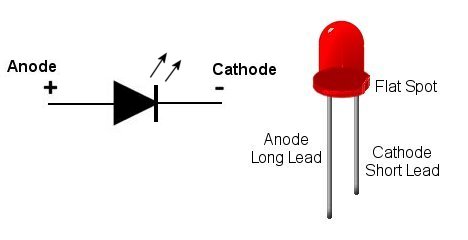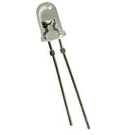LED's come in many different sizes, colors, brightness, and voltages. It is important that you match an LED
to the circuit being used. Normally a resistor is used to limit the current supplied to the LED.

Figure 1
Figure 1 shows an LED and it's schematic symbol, which looks like a diode symbol except for the two arrows.
Actually LED's are a special type of diode.
There is not much you need to know about LED's to complete projects other than
they do have a "polarity", that is you must know which way to put them in. Usually
the worst thing that will happen if you do put them in backwards is that they won't work.
Sometimes it can be a bit tough to spot but LED's come with a flat spot next to one of
the leads. LED's have a cathode and anode just like a diode does. Where diodes use a band to show the
cathode an LED uses the flat spot to denote the cathode. If you have a new LED on hand then the two
leads will be of different lenghts. The longer lead being the anode and the shorter being the cathode.
Also try to keep them organized as most of the newer LED's come with clear shells no matter
what color they are, if you get them mixed up the only way you will be able to tell them apart
is to power them up.
|



